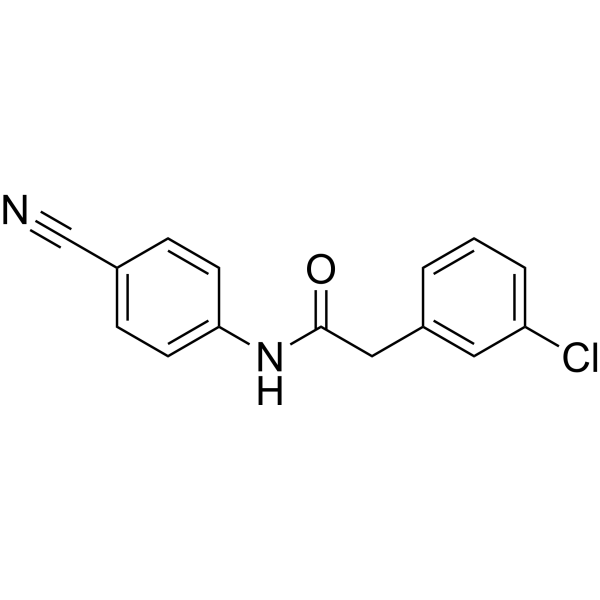Physicochemical Properties
| Molecular Formula | C15H11CLN2O |
| Molecular Weight | 270.71364235878 |
| Exact Mass | 270.055 |
| CAS # | 1274611-43-6 |
| PubChem CID | 55084117 |
| Appearance | White to off-white solid powder |
| LogP | 3.1 |
| Hydrogen Bond Donor Count | 1 |
| Hydrogen Bond Acceptor Count | 2 |
| Rotatable Bond Count | 3 |
| Heavy Atom Count | 19 |
| Complexity | 354 |
| Defined Atom Stereocenter Count | 0 |
| SMILES | C1(CC(NC2=CC=C(C#N)C=C2)=O)=CC=CC(Cl)=C1 |
| InChi Key | QUFHIWLHKLGWNH-UHFFFAOYSA-N |
| InChi Code | InChI=1S/C15H11ClN2O/c16-13-3-1-2-12(8-13)9-15(19)18-14-6-4-11(10-17)5-7-14/h1-8H,9H2,(H,18,19) |
| Chemical Name | 2-(3-chlorophenyl)-N-(4-cyanophenyl)acetamide |
| HS Tariff Code | 2934.99.9001 |
| Storage |
Powder-20°C 3 years 4°C 2 years In solvent -80°C 6 months -20°C 1 month Note: This product requires protection from light (avoid light exposure) during transportation and storage. |
| Shipping Condition | Room temperature (This product is stable at ambient temperature for a few days during ordinary shipping and time spent in Customs) |
Biological Activity
| Targets | MIC50: 0.25 - 8 μM (Gram-positive pathogens)[1] |
| ln Vitro | Antibacterial agent 125 exhibits efficacy against Gram-positive infections that are clinically significant, with MIC50 values ranging from 0.25 to 8 μM[1]. Methicillin-resistant strains of Staphylococcus aureus are inhibited by antibacterial agent 125 without causing cytotoxicity in human cells[1]. features an outstanding safety profile and strong metabolic stability[1]. After ten passages, antibacterial agent 125 does not cause resistance and has a moderate ability to suppress the formation of biofilms[1]. |
| References |
[1]. Isocyanides in med chem: A scaffold hopping approach for the identification of novel 4-isocyanophenylamides as potent antibacterial agents against methicillin-resistant Staphylococcusaureus. Eur J Med Chem. 2022 Nov 26;246:114950. |
Solubility Data
| Solubility (In Vitro) | DMSO : 250 mg/mL (923.50 mM) |
| Solubility (In Vivo) |
Solubility in Formulation 1: ≥ 2.08 mg/mL (7.68 mM) (saturation unknown) in 10% DMSO + 40% PEG300 + 5% Tween80 + 45% Saline (add these co-solvents sequentially from left to right, and one by one), clear solution. For example, if 1 mL of working solution is to be prepared, you can add 100 μL of 20.8 mg/mL clear DMSO stock solution to 400 μL PEG300 and mix evenly; then add 50 μL Tween-80 to the above solution and mix evenly; then add 450 μL normal saline to adjust the volume to 1 mL. Preparation of saline: Dissolve 0.9 g of sodium chloride in 100 mL ddH₂ O to obtain a clear solution. Solubility in Formulation 2: ≥ 2.08 mg/mL (7.68 mM) (saturation unknown) in 10% DMSO + 90% Corn Oil (add these co-solvents sequentially from left to right, and one by one), clear solution. For example, if 1 mL of working solution is to be prepared, you can add 100 μL of 20.8 mg/mL clear DMSO stock solution to 900 μL of corn oil and mix evenly. (Please use freshly prepared in vivo formulations for optimal results.) |
| Preparing Stock Solutions | 1 mg | 5 mg | 10 mg | |
| 1 mM | 3.6940 mL | 18.4699 mL | 36.9399 mL | |
| 5 mM | 0.7388 mL | 3.6940 mL | 7.3880 mL | |
| 10 mM | 0.3694 mL | 1.8470 mL | 3.6940 mL |
